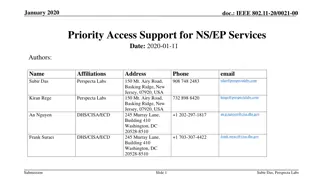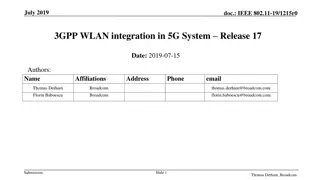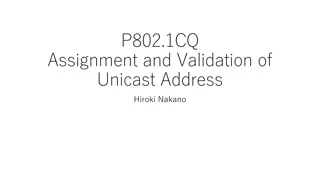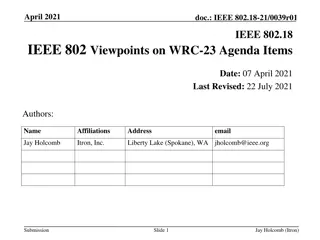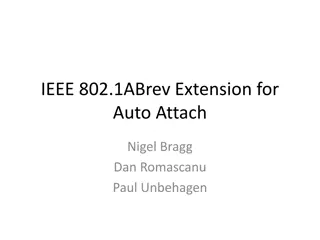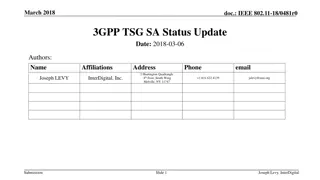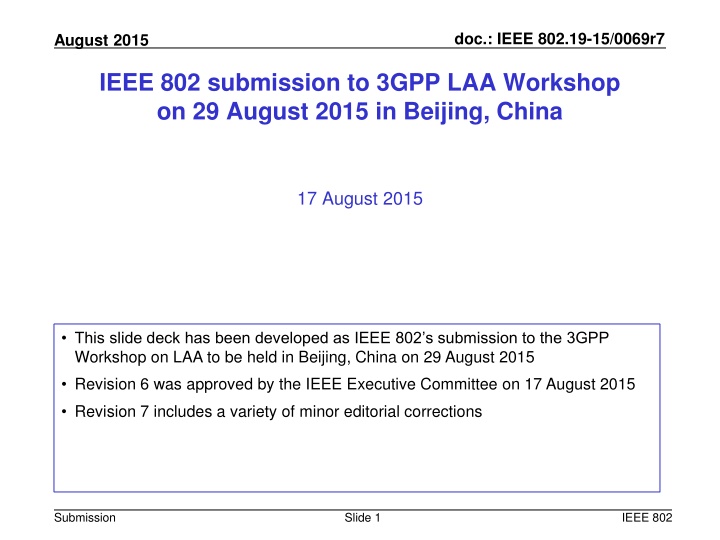
Collaboration Between IEEE 802 and 3GPP for Fair Spectrum Sharing
Explore the collaboration between IEEE 802 and 3GPP for fair spectrum sharing in unlicensed bands, focusing on proposing an 802.11-like access mechanism for LAA. The slides highlight the economic success of Wi-Fi globally and advocate for a collaborative development process for all stakeholders to ensure fair coexistence. Collaboration is key to addressing issues related to spectrum sharing between different technologies.
Download Presentation

Please find below an Image/Link to download the presentation.
The content on the website is provided AS IS for your information and personal use only. It may not be sold, licensed, or shared on other websites without obtaining consent from the author. If you encounter any issues during the download, it is possible that the publisher has removed the file from their server.
You are allowed to download the files provided on this website for personal or commercial use, subject to the condition that they are used lawfully. All files are the property of their respective owners.
The content on the website is provided AS IS for your information and personal use only. It may not be sold, licensed, or shared on other websites without obtaining consent from the author.
E N D
Presentation Transcript
doc.: IEEE 802.19-15/0069r7 August 2015 IEEE 802 submission to 3GPP LAA Workshop on 29 August 2015 in Beijing, China 17 August 2015 This slide deck has been developed as IEEE 802 s submission to the 3GPP Workshop on LAA to be held in Beijing, China on 29 August 2015 Revision 6 was approved by the IEEE Executive Committee on 17 August 2015 Revision 7 includes a variety of minor editorial corrections Submission Slide 1 IEEE 802
doc.: IEEE 802.19-15/0069r7 August 2015 The key to sharing unlicensed spectrum between LAA & 802.11 is collaboration between 3GPP & IEEE 802 The prospect of both LAA & 802.11 operating in the 5 GHz unlicensed band raises important issues related to fair sharing by very different technologies What is collaboration? The action of working with someone to produce something IEEE 802 welcomes the opportunity at today s workshop to start a process of true collaboration with 3GPP to ensure fair sharing Source: Oxford English Dictionary This deck consists of three topics for discussion today & in future sessions: 3GPP should consider 802.11-like access for LAA, using a collaborative development process Today s focus of discussion! Has the feasibility of the macro cell scenarios in 3GPP TR 36.889 been established? Questions & topics for future discussion A neutral test platform could provide a basis for collaboration between LAA & 802.11 stakeholders Submission Slide 2 IEEE 802
doc.: IEEE 802.19-15/0069r7 August 2015 3GPP should consider 802.11-like access for LAA, using a collaborative development process Submission Slide 3 IEEE 802
doc.: IEEE 802.19-15/0069r7 August 2015 3GPP should consider 802.11-like access for LAA, using a collaborative development process Wi-Fi (based on the IEEE 802.11 standard) has been a massive economic success globally + The significant benefit today from Wi-Fi of anyone, anytime, any place must not be put at risk An evidence based approach suggests the use of an 802.11-like access mechanism will promote fair sharing between LAA & Wi-Fi Collaboration: IEEE 802 requests 3GPP develop collaborative processes for all stakeholders to have a voice in LAA coexistence mechanisms IEEE 802 recommends that 3GPP adopt an 802.11-like access mechanism for LAA Submission Slide 4 IEEE 802
doc.: IEEE 802.19-15/0069r7 August 2015 Wi-Fi has been a massive socio-economic success in the US, in Europe and globally FCC Commissioner Jessica Rosenworcel stated at the 2015 State of the Net Conference: Wi-Fi is a boon to the economy. The economic impact of unlicensed spectrum (in the US) has been estimated at more than $140 billion annually and it's only going to grow. EC Study in 2013 found: More than 10 billion Wi-Fi devices sold worldwide! More than 5 billion devices in use today, and growing! European Commission Vice President Neelie Kroes stated in August 2013: Wi-Fi is a huge success. It s a win for everybody involved. I will make sure the European Commission helps to spread use of Wi-Fi through extra spectrum and lighter regulation. Submission Slide 5 IEEE 802
doc.: IEEE 802.19-15/0069r7 August 2015 and the significant benefit today from Wi-Fi of anyone, anytime, any place must not be put at risk Anyone Anytime Anyplace Wi-Fi meets users needs for data, voice, video and much more Wi-Fi trades some efficiency in favour of good enough performance (that still meets users needs) and fair sharing with other Wi-Fi networks and other technology networks Wi-Fi is also low cost, generally not requiring a subscription with a licensed operator! Submission Slide 6 IEEE 802
doc.: IEEE 802.19-15/0069r7 August 2015 An evidence based approach suggests 802.11-like access will promote fair sharing Evidence is vital to confirm unlicensed spectrum is shared fairly by LAA & Wi-Fi The importance of evidence based decision making in relation to LAA was emphasized both by regulators and other stakeholders at the recent ETSI BRAN meeting There is evidence for 802.11-like access Evidence for other access types is limited Evidence from 3GPP suggests an 802.11- like access mechanism is suitable for sharing 5 GHz channels Innovative new approaches to share the use of unlicensed spectrum must always be considered confirming 15 years of Wi-Fi experience that LBT (Listen Before Talk) with truncated exponential back off is a good solution but should only be adopted after detailed review and consensus by all stakeholders Evidence is available for the efficacy of 802.11-like access today! There is unlikely to be consensus on any evidence for a new access mechanism in the planned LAA & ETSI BRAN timescales Submission Slide 7 IEEE 802
doc.: IEEE 802.19-15/0069r7 August 2015 Evidence from 3GPP suggests 802.11-like access is suitable for sharing 5 GHz channels 3GPP TR 36.889 recommends a Category 4 LBT mechanism, with many similarities to 802.11, for downlink (DL) data, based on work undertaken by 3GPP during the first half of 2015 The TR leaves some parameters open for further study but the evidence currently suggests 802.11-like parameters work well; the TR specifies: The back off as dynamic variable or semi-static , but notes the most of the Category 4 evaluations in the TR are based on exponential back off CWmin and CWmax as configurable parameters, but almost all the Category 4 evaluations used CWmin = 16 and CWmax = 1024 Either ACK/NACK or sensing based feedback, but all the variations of feedback described for Category 4 use (delayed) ACK/NACK A variable defer period, but the vast majority of Category 4 simulations were based on defer periods of 34-43 s A slot length less than 20 s, but with almost all such simulations using a slot length of 9 s Submission Slide 8 IEEE 802
doc.: IEEE 802.19-15/0069r7 August 2015 confirming 15 years of Wi-Fi experience that LBT with truncated exponential back off is a good solution Wi-Fi provides 15 years of evidence that the 802.11 access mechanism using LBT with exponential back off provides fair coexistence between independent systems while also providing good performance that meets users needs + The 802.11 access mechanism successfully balances the optimal use of the channel fair sharing of a community resource This has been shown to be true over many years for many combinations of: Traffic loads Device densities Hidden stations Traffic types Up and down link traffic There is evidence that scheduled access does not work well in unlicensed spectrum based on market failures of (including approximate year of death ): ETSI HiperLAN 2 (~2000) IEEE 802.11 PCF (~1999) IEEE 802.11 HCCA (~2007) Submission Slide 9 IEEE 802
doc.: IEEE 802.19-15/0069r7 August 2015 3GPP should develop processes for all stakeholders to have a voice in LAA coexistence Collaboration Who should decide what is fair access to the unlicensed 5 GHz band? Regulators? Industry consensus? Not ideal Best option How do we ensure the best option is feasible? IEEE 802 is concerned that 3GPP does not have processes that promote effective collaboration and thus industry consensus IEEE 802 requests 3GPP allow formal external review for LAA, possibly based on the processes used by IEEE-SA Submission Slide 10 IEEE 802
doc.: IEEE 802.19-15/0069r7 August 2015 Fair access to 5 GHz band could be decided by regulators alone or by industry consensus Collaboration The 5 GHz band is a community resource that must be available for fair sharing by all stakeholders However, defining what is fair is a difficult problem with many dimensions and conflicting interests e.g., fair means absolute priority for radars in 5 GHz band e.g., fair means similar throughput & delay for many stakeholders e.g., fair means no unlicensed user has special rights for many stakeholders It is generally agreed that it is unacceptable for one part of industry to decide how fair sharing should occur on behalf of the rest That leaves two main methods to decide how to share the unlicensed 5 GHz band: The regulator decides the rules on behalf of all stakeholders The industry & the regulator comes to a consensus on the rules after a process of collaboration Submission Slide 11
doc.: IEEE 802.19-15/0069r7 August 2015 Intervention by regulators is not ideal, but is a real possibility without effective collaboration Collaboration Regulators have a general responsibility to set regulations to ensure the interests of all stakeholders are protected Regulators usually prefer that the stakeholders collaborate, leading to a consensus that the regulator can simply implement They also usually prefer a consensus that results in less need for detailed regulations because they are hard to enforce and may stifle innovation The lack of industry collaboration or consensus on fair sharing of the 5 GHz band means that regulators could start imposing rules It appears that the FCC is exploring this possibility in the US based on the recent Public Notice; many submissions note the lack of collaboration The European regulators already impose some rules, although they are developed using a process in which industry can participate (ETSI BRAN) Regulators imposing rules not ideal because it takes decisions about LAA & 802.11 away from the experts in 3GPP and IEEE 802 Submission Slide 12 IEEE 802
doc.: IEEE 802.19-15/0069r7 August 2015 IEEE 802 is concerned that 3GPP do not have processes that promote effective collaboration Collaboration Effective collaboration on sharing the 5 GHz band is the best way to satisfy stakeholders with the outcome Collaboration implies joint work and consensus outputs; communication is not the same as collaboration! IEEE 802 would like to collaborate effectively with 3GPP on mechanisms for LAA and 802.11 to fairly share the 5 GHz band However, IEEE 802 is concerned that 3GPP does not have processes that encourage external collaboration on issues related to LAA sharing It appears 3GPP has no formal LAA review processes accessible to external stakeholders, particularly other users of 5 GHz unlicensed spectrum IEEE 802 were told by 3GPP RAN in January 2015 that the best way to influence 3GPP, particularly operator members, is to participate directly in 3GPP Many IEEE 802 participants believe that 3GPP has dismissed many of the comments received via Liaison Statements from IEEE 802 The current 3GPP timelines for LAA appear to have insufficient time for proper review by IEEE 802 or other external stakeholders Slide 13 Submission IEEE 802
doc.: IEEE 802.19-15/0069r7 August 2015 IEEE 802 requests 3GPP allow formal external review for LAA, possibly based on IEEE- SA processes Collaboration IEEE 802 requests 3GPP develop processes allowing all stakeholders to have an opportunity to review and influence LAA IEEE has external review processes IEEE-SA has defined processes that allow a diversity of stakeholders to have a voice: The Sponsor Ballot allows all stakeholders to comment on and have a vote on draft standards Historically, any stakeholder could enter a rogue comment , which must be resolved in the same way comments by voters are resolved The rogue comment process has recently been formalized by IEEE-SA as part of the Public Review Process The focus should be on collaboration related to fairly sharing the 5 GHz band IEEE 802 suggests 3GPP consider using external review processes similar to those used by IEEE-SA These processes have particular value in resolving coexistence issues between systems based on IEEE standards and other systems Submission Slide 14 IEEE 802
doc.: IEEE 802.19-15/0069r7 August 2015 IEEE 802 recommends that 3GPP adopt an 802.11-like access mechanism for LAA The following slides contain a set of principles that IEEE 802 recommends be considered for adoption by 3GPP for LAA The principles are not intended to represent detailed specifications because that is the responsibility of 3GPP, and not IEEE 802 The goal of these recommendations are to enable LAA & Wi-Fi to share the unlicensed 5 GHz band fairly and ultimately to allow the unlicensed 5 GHz band to continue to be a community resource available for all! In summary, various principles are proposed that LAA adopt: 802.11-like parameters to maximize the probability of coexistence 802.11-like access rules because they are effective in unlicensed spectrum A variety of other mechanisms to promote fair sharing Submission Slide 15 IEEE 802
doc.: IEEE 802.19-15/0069r7 August 2015 It is proposed that LAA adopt 802.11-like parameters to maximise probability of coexistence Adopt 802.11-like timing parameters to maximize the probability of coexistence Summary Principle Definitions based on 802.11 Proposal Define busy & free states based on received energy & channel reservations Proposal Divide the free period into slots Proposal Define a defer period Define Energy Detect (ED) & Preamble Detect (PD) thresholds Proposal Submission Slide 16 IEEE 802
doc.: IEEE 802.19-15/0069r7 August 2015 Principle: adopt 802.11-like timing parameters to maximize the probability of coexistence The reality is that 802.11 standard has defined various timing parameters that are deployed in billions of Wi-Fi devices e.g., slot times, CCA mechanism, AIFS mechanism Defining LAA to use completely different timing parameters to those used in 802.11 is likely to make fair sharing much harder ... and specifying LAA to use similar timing parameters to 802.11 is unlikely to make LAA any less functional Principle: IEEE 802 recommends 3GPP adopt a limited number of timing parameters taken directly from the 802.11 access mechanism This approach is aligned with the Ericsson proposal in 3GPP and ETSI BRAN in relation to defer and slot times and much of the simulation work undertaken during the 3GPP Study Item Submission Slide 17 IEEE 802
doc.: IEEE 802.19-15/0069r7 August 2015 Proposal: define busy & free periods based on received energy & channel reservations It is proposed by IEEE 802 that LAA use concepts of a busy and free medium similar to those used in 802.11 Note: 3GPP does not need to adopt exactly the same terms as 802.11 Define:a wireless medium is deemed to be busy by a device for the period the device: Receives energy above an energy threshold Transmits energy on the medium The device is aware another device has reserved the channel Reservation occurs by the use of NAV in 802.11 The device is aware another device is probably transmitting on a channel This idea encapsulates the EIFS concept in 802.11 and an additional defer period Defined on a following slide Define: In all other circumstances the medium is deemed to be free Submission Slide 18 IEEE 802
doc.: IEEE 802.19-15/0069r7 August 2015 Proposal: divide the free period into slots It is recommended by IEEE 802 that LAA adopt concepts of a slot similar to that used in 802.11 Define: The period the medium is free is divided into slots Define: Energy Detection (ED) shall occur during each slot An 802.11 system must be capable of detecting energy (with 90% probability) and executing any other necessary actions, such as processing and turnaround, within each slot period Define: Each slot has a period of 9 s Note: this is the same as 802.11 Note: 802.11 systems must detect energy in each slot within 4 s, leaving 5 s for propagation delay, processing time & turnaround time; other technologies may use different timing Submission Slide 19 IEEE 802
doc.: IEEE 802.19-15/0069r7 August 2015 Proposal: define a defer period It is proposed by IEEE 802 that LAA adopt concepts of a defer period similar to that used in 802.11 PIFS, DIFS in the DCF (Distributed Coordination Function) version of 802.11 AIFS in the EDCA (Enhanced Distributed Channel Access) version of 802.11 Note: PIFS, DIFS, SIFS, AIFS are different Inter-frame Spaces in 802.11 Define: The defer period is defined to be of length (16 s + n * slot times), n >= 1, and consists of 16 s that is analogous to SIFS in 802.11 followed by one or more slots The value of n depends on the priority level See later in this deck for discussion related to priority Energy detection is assumed to occur during each of the slots in the defer period Submission Slide 20 IEEE 802
doc.: IEEE 802.19-15/0069r7 August 2015 Proposal: define Energy Detect (ED) & Preamble Detect (PD) thresholds Simulations with 20 MHz channels in 3GPP during the Study Item suggest fairness will be enhanced by LAA adopting: Energy detection (ED) less than -77 dBm OR Based on work during 3GPP SI; see R1-152936, R1-152937 & R1-152938 Preamble detection (PD) at -82 dBm & ED at -62 dBm (same as 802.11) Proposal: It is proposed that 3GPP adopt one of the above mechanisms and the associated thresholds: An ED less than -62 dBm has the beneficial side effect of assisting LAA systems mitigate hidden station issues with Wi-Fi systems PD is not strictly technology neutral but its use pragmatically recognizes legacy equipment can t be changed; it also assists hidden station mitigation, at least with other Wi-Fi devices Submission Slide 21 IEEE 802
doc.: IEEE 802.19-15/0069r7 August 2015 It is proposed that LAA use 802.11-like access rules because they are effective in unlicensed spectrum Define LBT rules in terms that allow flexibility and innovation, within limits Medium access based on 802.11 Principle Execute LBT and exponential back-off mechanisms before any transmission Proposal Allow some control frames to be transmitted without any LBT Proposal Count a random number of slots within a contention window as a back-off procedure Proposal Adjust contention window based on successful & unsuccessful transmission of frames Proposal Enable QoS using multiple access engines in a device Principle Set minimum parameters for QoS Principle Devices must undertake LBT before accessing secondary channels Principle Submission Slide 22 IEEE 802
doc.: IEEE 802.19-15/0069r7 August 2015 Principle: define LBT rules in terms that allow flexibility and innovation, within limits Principle: IEEE 802 proposes that an LAA device use an LBT plus truncated, exponential back-off mechanism for medium access This proposal is roughly aligned with DCF and EDCA in 802.11, and WMM from the Wi-Fi Alliance It is also roughly aligned with the Category 4 LAA concept in 3GPP Study Item The rest of this submission defines the mechanism in terms that allows LAA a significant degree of flexibility in implementation details This approach enables innovative solutions, while also achieving the goal of fair sharing of unlicensed spectrum Fair sharing is a goal article that is agreed in many regulatory domains, including under 3.2 of the RE-Directive in Europe Submission Slide 23 IEEE 802
doc.: IEEE 802.19-15/0069r7 August 2015 Proposal: execute LBT and exponential back-off mechanisms before and after any transmission Define: An access engine within a device may transmit consecutive multiple frames (within a TxOP) starting on a slot boundary if: The medium is free AND Any back-off procedure has completed AND No higher priority access engine in the same device is eligible to transmit Define: An access engine within a device must execute a back-off procedure: When the medium is busy at the time it queues the first frame in the TxOP for transmission OR After transmission of a complete TxOP OR When an access engine in the same device at a higher priority level causes a transmission deferral (see later discussion wrt QoS) Submission Slide 24 IEEE 802
doc.: IEEE 802.19-15/0069r7 August 2015 Proposal: allow some control frames to be transmitted without any LBT Normally the access mechanism must operate before any transmission but there are exceptions in 802.11 This is to provide for ACKs, CTSs, etc. in 802.11 Similar exceptions are in ETSI BRAN rules Proposal: a short control frame may be transmitted immediately after a reception of a frame from another access engine without checking for a free medium In 802.11, the control frames are sent at SIFS, ensuring other systems cannot grab the medium during the turnaround Note: an alternative approach might be to allow a limited duty cycle for control frames Submission Slide 25 IEEE 802
doc.: IEEE 802.19-15/0069r7 August 2015 Proposal: count a random number of slots within a contention window as a back-off procedure Define: The back-off procedure in each access engine in a device is driven by a parameter called CW (Contention Window), which may take values between: CWmin: minimum value of CW CWmax: maximum value of CW Define: A back-off procedure in each access engine operates as follows: Choose a random number q between 0 and CW Count q slots Note: a back-off procedure will implicitly countdown only while the medium is free because slots are defined to be free Submission Slide 26 IEEE 802
doc.: IEEE 802.19-15/0069r7 August 2015 Proposal: adjust contention window based on successful & unsuccessful transmission of frames Each access engine in a device adjusts its CW independently Define: CW is initially reset to CWmin, and has a maximum of CWmax Define: CW is reset to CWmin when evidence is received that the first frame in a past TxOP has been successfully received e.g., an immediate ACK in 802.11, a delayed ACK in LAA Define: CW may also be reset after a system defined number of consecutive transmission failures Note: this is analogous to the retry counts in 802.11 Define: CW is doubled (plus one) each time: Evidence is received that the first frame in a past TxOP has not been successfully received e.g., evidence could be from missing ACK in 802.11, a delayed NACK in LAA An access engine has an internal collision with higher priority access engine Submission Slide 27 IEEE 802
doc.: IEEE 802.19-15/0069r7 August 2015 Principle: enable QoS using multiple access engines in a device 3GPP does not appear to have considered QoS for LAA in their simulations to date QoS is enabled in 802.11 using EDCA (Enhanced Distributed Channel Access) via four access engines operating in parallel within a device The priority levels are voice, video, best effort (typical) and background Each priority level is defined by tuple of: (CWmin, CWmax , defer period, TxOPmax) Principle: 3GPP should adopt a similar QoS concept , if QoS is required in LAA, because it is a proven and mature mechanism Question: Does 3GPP want DL QoS, or is best effort enough? While this proposal does not limit when higher priority access may be used, it is expected that devices would use higher priorities responsibly Submission Slide 28 IEEE 802
doc.: IEEE 802.19-15/0069r7 August 2015 Principle: set minimum parameters for QoS Level Priority n CWmin CWmax TxOPmax Highest Voice 2 3 7 1.5 ms Next highest Video 2 7 15 3.0 ms Typical Best effort 3 15 1023 4.0 ms Lowest Background 7 15 1023 4.0 ms Note: these parameters are defined to be the similar to those in 802.11 EDCA and Wi-Fi Alliance WMM Note: Wi-Fi Alliance WMM defines slightly relaxed parameters for APs Submission Slide 29 IEEE 802
doc.: IEEE 802.19-15/0069r7 August 2015 Principle: devices must undertake LBT before accessing secondary channels The access mechanisms described in this document are based on access to a 20 MHz channel However, 802.11 accesses 40 MHz, 80 MHz, 160 MHz too, and presumably LAA will want the same flexibility It is proposed that LAA use a similar mechanism to 802.11 to access secondary channels i.e. channels in which the basic access mechanism is not used Principle: This means that at least a short LBT is undertaken in secondary channels after execution of a full access procedure in the primary channel Submission Slide 30 IEEE 802
doc.: IEEE 802.19-15/0069r7 August 2015 Summary: Access engine operation can be illustrated by a conceptual flow diagram Wait for frame Start State Free at end of slot? N State is Busy ? Y Note: This diagram is not intended as a detailed specification but rather a statement of principles N Y Set q = rand[0, CW] Y Is higher priority q=0? Wait until state is Free N Transmit frame Y q = 0? Y Frame ready to tx? N N Y State Free at end of slot? N Set q = q -1 Note: CW, Free and Busy are defined on earlier slides Submission Slide 31 IEEE 802
doc.: IEEE 802.19-15/0069r7 August 2015 Summary: The revised flow chart removes iCCA because it is ambiguous and overly conservative Wait for frame to be queued The 3GPP Category 4 flowchart includes a concept called iCCA It appears from discussions at ETSI BRAN that some 3GPP participants believed an iCCA was required in Wi-Fi after a frame became ready for transmission This is not the case; rather an instantaneous evaluation of the medium state is required Start State Free at end of slot? N State is Busy ? Y Note: This diagram is not intended as a detailed specification but rather a statement of principles N Y Set q = rand[0, CW] Y Is higher priority q=0? Wait until state is Free N Transmit frame If the flow chart means that an iCCA is always required after the frame becomes available for transmission, then this is overly conservative IEEE 802 recommends that the iCCA concept be refined to align better with the 802.11 access mechanism Y q = 0? Y Frame ready to tx? N N Y State Free at end of slot? N Set q = q -1 Note: CW, Free and Busy are defined on earlier slides Submission Slide 32 IEEE 802
doc.: IEEE 802.19-15/0069r7 August 2015 Summary: The revised flow chart ensures transmissions occur on slot boundaries Wait for frame to be queued Start State Free at end of slot? N State is Busy ? Y Note: This diagram is not intended as a detailed specification but rather a statement of principles N Y The 3GPP Category 4 flow chart does not force transmission on the access slot boundaries in all cases Set q = rand[0, CW] Y Is higher priority q=0? Wait until state is Free N Transmit frame This smearing of the contention window will adversely affect both 802.11 & LAA Not using slot sync makes access more like ALOHA, and less like slotted ALOHA IEEE 802 recommends the Category 4 flow chart be refined to transmit only on slot boundaries Y q = 0? Y Frame ready to tx? N N Y State Free at end of slot? N Set q = q -1 Note: CW, Free and Busy are defined on earlier slides Submission Slide 33 IEEE 802
doc.: IEEE 802.19-15/0069r7 August 2015 Summary: The revised flow chart incorporates EDCA as the basis for access Wait for frame to be queued Start State Free at end of slot? N State is Busy ? Y Note: This diagram is not intended as a detailed specification but rather a statement of principles N Y Set q = rand[0, CW] Y The mechanism shown here is Is higher priority q=0? Wait until state is Free N Transmit frame representative of 802.11 EDCA IEEE 802 would like to collaborate with 3GPP to help define LAA in a way that satisfies the particular needs of 3GPP stakeholders, while sharing the unlicensed spectrum fairly with Wi-Fi Y q = 0? Y Frame ready to tx? N N Y State Free at end of slot? N Set q = q -1 Note: CW, Free and Busy are defined on earlier slides Submission Slide 34 IEEE 802
doc.: IEEE 802.19-15/0069r7 August 2015 Summary: The revised flow chart incorporates QoS by enabling multiple parallel access engines Wait for frame to be queued Start QoS is enabled by multiple parallel access engines , with higher priority having precedence State Free at end of slot? N State is Busy ? Y Note: This diagram is not intended as a detailed specification but rather a statement of principles N Y Set q = rand[0, CW] Y Is higher priority q=0? Wait until state is Free N Transmit frame Y q = 0? Y Frame ready to tx? N N Y State Free at end of slot? N Set q = q -1 Note: CW, Free and Busy are defined on earlier slides Submission Slide 35 IEEE 802
doc.: IEEE 802.19-15/0069r7 August 2015 It is proposed that LAA adopt a variety of other principles to promote fair sharing Define the maximum transmission time of 4 ms for each access Other principles Proposal Do not require LAA to respect NAV received from 802.11 Principle Devices shall have mutual respect for reservations made by others using same mechanisms Principle Collaboration is needed to discuss LBT on TxOPs continued on UL Proposal Devices using or reserving a channel shall use it only for necessary transmission purposes Proposal Submission Slide 36 IEEE 802
doc.: IEEE 802.19-15/0069r7 August 2015 Proposal: define the maximum transmission time of about 4 ms for each TxOP Define: a TxOP is the contiguous frame transmissions that result from an access engine gaining access to the medium Note: it is assumed a TxOP can be split between DL and UL The evidence suggests a TxOPmax of ~4 ms as a reasonable compromise between fairness and efficiency Most Category 4 simulations used a TxOPmax of about 4 ms, and showed reasonable fairness and performance with exponential back-off; some simulations showed that a TxOPmax of 10 ms was too long Measurements in the field (e.g., in a stadium) show that the vast majority of Wi- Fi TxOPs are less than 3 ms; the maximum Wi-Fi TxOP is 5.5 ms Qualcomm noted in their submission to FCC that Wi-Fi data packet transmissions are usually a few milliseconds in duration. LAA transmission duration is expected to be on the same order as the duration of Wi-Fi data packet transmission Japan has a regulation specifying a TxOPmax of 4 ms Submission Slide 37 IEEE 802
doc.: IEEE 802.19-15/0069r7 August 2015 Principle: do not require LAA to respect NAV received from 802.11 802.11 partially resolves hidden station problems by its use of the NAV in frames, and particularly its use of RTS/CTS control frames e.g., NAV in data frames protects ACK in Wi-Fi These hidden station mitigation techniques may be less effective if LAA does not respect the NAV in frames transmitted by 802.11 devices It has been argued by some stakeholders that LAA devices should be required to respect the NAV transmitted by all 802.11 devices However, such an approach is not technology neutral and unreasonably forces every LAA device to implement an 802.11 receive function Respecting the NAV might also be unnecessary if the LAA devices use a lower ED of -77 dBm as an alternative form of hidden station mitigation It may be possible for IEEE 802 and 3GPP to work together to define a reciprocal collision avoidance mechanism Submission Slide 38 IEEE 802
doc.: IEEE 802.19-15/0069r7 August 2015 Principle: devices shall have respect for reservations made by others using common mechanisms It is generally agreed that it is unacceptable to require LAA to respect an 802.11 NAV because such an approach is not technology neutral However, there have been some indications that LAA systems may transmit 802.11 CTS-to-Self control frames to reserve the medium It is only fair that if a LAA system expects 802.11 systems to respect a NAV it transmits then the same LAA system should respect any NAV received from 8021.11 systems Principle: This principle can be generalised by requiring any system using a particular mechanism to reserve the medium shall respect reservations made by other systems using the same mechanism Submission Slide 39 IEEE 802
doc.: IEEE 802.19-15/0069r7 August 2015 Proposal: collaboration is needed to discuss LBT on TxOPs continued on UL Most of the 3GPP simulations focused in LAA DL only scenarios, but there are plans for LAA to support UL traffic too in the future A potential problem is that the UE is scheduled by the eNB, suggesting the UE may not undertake any form of LBT before transmission Any possibility of hidden stations suggests that UEs also need to execute at least some sort of LBT to ensure fair sharing of the channel Proposal: Discussion of this topic by IEEE 802.11 WG participants suggests any form of LBT not based on Category 4 needs detailed investigation using simulations and analysis, by 3GPP, IEEE 802 and any other interested stakeholders Submission Slide 40 IEEE 802
doc.: IEEE 802.19-15/0069r7 August 2015 Proposal: devices using or reserving a channel shall use it only for necessary transmission purposes Some of the proposals for LAA appear to allow the channel to be reserved before it is needed so that it is available when it is needed This could result in the LAA system reserving but not using the channel, effectively representing interference to Wi-Fi This is contrary to the widely accepted principle in unlicensed spectrum to accept interference from others but to avoid causing interference to others Proposal: It is proposed that any system reserving or using a channel must only make use of it for necessary and legitimate data and management transmission purposes Submission Slide 41 IEEE 802
doc.: IEEE 802.19-15/0069r7 August 2015 IEEE 802 welcomes the opportunity to collaborate with 3GPP to ensure LAA & Wi-Fi share fairly Wi-Fi s operation must not be threatened in 5 GHz unlicensed spectrum LAA has every right to use the same 5 GHz unlicensed spectrum as Wi-Fi LAA The currently available evidence shows the best way for LAA and Wi-Fi to share the 5 GHz unlicensed spectrum is for LAA to adopt 802.11-like access IEEE 802 is ready and willing to work with 3GPP in a truly collaborative manner to achieve our common goal of LAA & Wi-Fi sharing the 5 GHz unlicensed spectrum fairly + Submission Slide 42 IEEE 802
doc.: IEEE 802.19-15/0069r7 August 2015 Backup: 3GPP and IEEE 802 flow charts are similar, but sufficiently different to require collaboration 3GPP Category 4 Flow Chart IEEE 802 conceptual flow chart Similar Same DCF vs EDCA Essentially the same Same Similar, but different Essentially the same Missing Missing Essentially the same Wait for frame Start State Free at end of slot? N Y State is Busy ? N Y Set q = rand[0, CW] Y Wait until state is Free N Is higher priority q=0? Transmit frame Y q = 0? Y N N Frame ready to tx? Y N State Free at end of slot? Set q = q -1 Note: slide contains animations Submission Slide 43 IEEE 802
doc.: IEEE 802.19-15/0069r7 August 2015 Has the feasibility of the macro cell scenarios in 3GPP TR 36.889 been established? Submission Slide 44 IEEE 802
doc.: IEEE 802.19-15/0069r7 August 2015 Has the feasibility of the macro cell scenarios in 3GPP TR 36.889 been established? 3GPP TR 36.889 V1.0.1 (2015-06) provides a carrier aggregation feasibility study Macrocell scenarios are included The one macrocell scenario evaluated in TR 36.889 requires different licensed bands for macrocell and small cell The other macrocell scenarios may result in unique challenges for LBT Has the feasibility of the macro cell scenarios been established? Submission Slide 45 IEEE 802
doc.: IEEE 802.19-15/0069r7 August 2015 3GPP TR 36.889 defines four LAA deployment scenarios source: 3GPP TR 36.889 Submission Slide 46 IEEE 802
doc.: IEEE 802.19-15/0069r7 August 2015 3GPP TR 36.889 conclusions are based on two LAA evaluation scenarios per TR 36.889, indoor scenario based on Scenario 3 of TR 36.872 but comparable to Scenario 2 of TR 36.889 per TR 36.889, outdoor scenario based on Scenario 2a of TR 36.872 but comparable to Scenario 4 of TR 36.889 Submission Slide 47 IEEE 802
doc.: IEEE 802.19-15/0069r7 August 2015 The three macro-cell scenarios are not evaluated or have limited applicability Scenario 4 is evaluated in TR 36.889 requires different licensed channels for macro and small cell limited applicability: not all operators have multiple licensed channels available Scenario 1 is not evaluated in TR 36.889 Requires ideal backhaul between the macro site and the unlicensed small cell. DL and UL scheduling take place at the macro site, not at remote radio head. CCA takes place at the small cell, and at remote UE for uplink. Scenario 3 is not evaluated in TR 36.889 Macrocell and small cell share the same licensed channel. may require coordination of scheduling between macrocell and small-cell licensed Submission Slide 48 IEEE 802
doc.: IEEE 802.19-15/0069r7 August 2015 There are open questions relating to macro-cell scenarios 1 & 3 that could be subject to collaboration Scenario 1 Scenario 3 Is the scheduler, at the macrocell, aware of remote CCA status? In case of ideal backhaul, see questions from Scenario 1. Have simulations studied LBT in Scenario 1? Do these consider: ideal but realistic backhaul latency when unlicensed uplink is supported, latency in passing CCA status from UE over the air (using licensed or unlicensed uplink) In case of non-ideal backhaul, have simulations studied LBT? Can the presence of the macro-cell affect the latency of the DL and UL LBT operation, considering that small-cell licensed and unlicensed carriers are carrier-aggregated while licensed small-cell operation is not independent but must be coordinated with co-channel macro- cell? Submission Slide 49 IEEE 802
doc.: IEEE 802.19-15/0069r7 August 2015 A neutral test platform could provide a basis for collaboration between LAA & 802.11 stakeholders Submission Slide 50 IEEE 802




